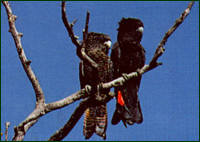| |
Hopetoun
is a small Mallee town providing the main gateway to the Wyperfeld
National Park. The town was named after the seventh Earl of Hopetoun,
first governor of Australia. Hopetoun was a frequent visitor to
the home of Edward Lascelles, who was largely responsible for opening
up the Mallee area.
Things to Do and See
Two historic homes classified by the National Trust are located
in Evelyn St. Hopetoun House (1891), built for Lascelles and Corrong
Homestead (1846), home of Peter McGinnis, the first European settler
in the area.
There are few birds in the world as interesting and industrious
as the Lowan, or Mallee fowl, a unique bird which in years past
was in danger of being exterminated by a rapid increase in clearing,
grazing and burning of the Mallee areas in Australia. Fortunately
this bird is now protected in North Western Victoria by the Wyperfeld
and Little Desert National Parks, as well as the Wathe Reserve,
just north of the small township of Lascelles, which contains breeding
populations of the Mallee fowl.
Other Points of Interest
Mallee mural and leadlight window in the Shire Offices, Lascelles
St, depict the history of the Mallee.
Lake Lascelles offers good boating, swimming and picnicing.
Events
Air Sports Festival -Feb.
Country Music Festival - Easter.
Agricultural Show - Oct.
Wyperfeld National Park
One of our most fascinating national parks, is Wyperfeld National
Park, located in the flat, semi-arid north-western corner of Victoria.
The beauty of the park lies in it's wide open spaces where emus
and kangaroos can be seen, grazing at dawn and dusk in the dry lakebeds
and creeks.
The central feature of this large 356,800ha park, is a chain of
lake beds. The lakes only fill when the Wimmera River over-supplies
Lake Hindmarsh to the south of Lake Albacutya. When it rains the
semi-arid landscape is transformed by tiny desert plants that sprout
from long-dormant seeds, carpeting the ground with clusters of flowers.
Things to see and do
Camping and bushwalking are popular activities in the park. The
Eastern Lookout Nature Drive is highly recommended as a good introduction
to the park. Two self-guided nature walks, one at Lake Brambruk
and the other at Black Flat Lake, enable a close look at the plant
and animal life of Wyperfeld. Spring is the best time to see the
wildflowers.
Facilities
The Information Centre near the main camping ground has displays
and information about the park. The large wooded picnic and camping
area in the south of the park caters for most park visitors. Facilities
include a picnic shelter, tables, fireplaces, toilets, and water
for drinking and handwashing. General supplies and accommodation
are available in Yaapeet, Hopetoun and Rainbow.
Heritage
Before the arrival of the Europeans, Aboriginal people regularly
moved north along Outlet Creek in search of food. Evidence shows
that they occupied the area for at least 6000 years, but because
of the low and unreliable water supply, they rarely stayed in one
place for long. From the 1860's European settlers followed and set
about clearing the mallee for grazing and wheat growing. In 1909
a number of naturalists persuaded the government to temporarily
reserve 3900 ha of this fast-disappearing habitat. Wyperfeld National
Park was declared in 1921, and has been considerably enlarged in
recent years.
Flora & Fauna
There are around 450 species of plants native to the park. They
occur in distinct communities which can all be seen close to the
campgrounds. River Red Gum and Black Box woodlands cover the floodplains
of Outlet Creek and the lakes. Mallee eucalypts cover most of the
eastern section of the park while rolling sand plains covered with
heathland predominate the western section.
Animals living in the mallee are adapted to an arid, sandy habitat
with a pattern of irregular rainfall. Emus and western grey kangaroos
are common and can usually be seen grazing on the dry lake beds
and surrounding woodlands at dawn and dusk. More than 200 bird species
have been recorded, including Sulphur Crested Cockatoos, Mallee
Ringneck Parrots, Red-rumped parrots, galahs, eagles and smaller
birds such as variegated Fairy-wrens and Red-capped robins. Of particular
interest is the Mallee Fowl. This rare bird incubates its eggs in
a large mound of earth and leaf litter.
How to get there
Wyperfeld National Park is 450 km north-west of Melbourne (Melway
520 A3). A sealed road gives access to the main camping/picnic ground
from Hopetoun or Rainbow. Casuarina campground is reached from Patchewollock.
Four wheel drive access to the western park areas is via Murrayville
Track, but check with the rangers during wet weather.
For more information on Wyperfeld National Park, call the Parks
Victoria Information Line on 13 1963 or visit Parks Victoria's website
on www.parks.vic.gov.au
How to Get There
Hopetoun is 390kms north-west of Melbourne
Melways Ref: 520 C4
Pop: 800
Visitor Information
71 Lascelles St
Tel: (03) 5083 3093
Back to Top
|
|

Birdlife abounds in the Wimmera.
Lookout for the endangered Redtailed Black Cockatoo. |